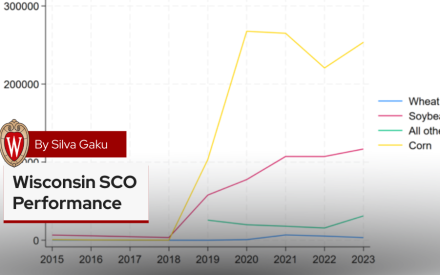Margin Coverage Option (MCO) is a new crop insurance option available to Wisconsin farmers. MCO offers protection against unexpected drops in operating margins — the difference between revenue and input cost. MCO uses county yields, Chicago Mercantile Exchange (CME) futures prices, and major input prices on the CME or New York Mercantile Exchange (NYMEX) to calculate margins on an area-wide basis as the difference between expected area revenue and expected area operating costs.
MCO is an option that is added onto a producer’s Revenue Protection (RP) or Yield Protection (YP) policy and can be combined with the Supplemental Coverage Option (SCO). Producers can choose any standard coverage level for their RP or YP policy whether irrigated or non-irrigated, but organic practices are not insurable under this policy. MCO cannot be combined with the Enhanced Coverage Option (ECO), nor can it be added to an Area Revenue Protection, Area Yield Protection, or Margin Protection crop insurance policy. Like ECO and SCO, the MCO premium is subsidized up to 80%. Lastly, MCO has no restrictions on participation in Agriculture Risk Coverage (ARC) or Price Loss Coverage (PLC).
Note that MCO relies on county yields and CME price, not a farm’s actual yields and prices, and the margin calculation uses CME or NYMEX input prices and assumed application rates, not a farm’s actual input costs. However, much like the area-wide policies, a farm’s actual revenue and costs are likely similar in level and follow the same trends.
At MCO enrollment, farmers choose either the 86% to 95% coverage band or the 86% to 90% coverage band. Indemnities are triggered when the harvest margin is less than either 90% or 95% of the expected margin (whichever the producer chooses). At enrollment, farmers also choose the MCO coverage factor that operates like a payment rate. If a margin loss occurs, the farmer is paid from 50% to 100% of the loss based on the coverage factor chosen at enrollment.
Corn input costs are determined by diesel, natural gas, diammonium phosphate (DAP), urea and potash exchange prices; soybeans input costs calculations use all the same input price contracts except for urea. Initial MCO margins are set using average contract prices from Aug. 15 to Sept. 14. The initial expected input costs are calculated using the average for the May input contracts, and then the final input costs are calculated using the average of the May contracts during April. The initial expected crop revenue is calculated using the average of the 2026 December corn and November soybean contract prices from Aug. 15 to Sept. 14 of 2025, and then the final input costs are calculated using the average of the same contracts during October of 2026. Thus, MCO margins are set in September of 2025, but because 2026 county yields are not reported until March of 2027, it will be spring of 2027 before actual margins can be calculated and MCO indemnities paid if triggered.
Interested producers should contact their crop insurance agent to learn more about how MCO could work for their operation. However, time is short, as the sales closing date is September 30, 2025. MCO allows farmers to set projected prices for their corn or soybeans this fall, much earlier than for traditional crop policies and options like RP, ECO, and SCO, which some farmers may prefer. Crop price dynamics between now and February of 2026 have large impacts on the value of MCO relative to ECO and SCO, but only for the 86% to 90% or 95% of expected revenue, as the underlying RP policy for all these options still operates on the February to October time frame of the harvest time contract. Lastly, the margin is calculated using fuel and fertilizer prices, but farms face other input cost risks as well. Also, some of these futures markets for these inputs have few contracts traded, suggesting that these prices may differ from actual farmer costs.
MCO offers farmers a new crop insurance option for managing some aspects of margin risk, but farmers now have multiple such options available for managing “shallow risks”. Farmers will have to evaluate MCO, ECO, SCO and Margin Protection to see if these options or policies provide value for their operations.

 Wisconsin Supplemental Coverage Option (SCO) Performance
Wisconsin Supplemental Coverage Option (SCO) Performance Forage Risk Management in Wisconsin, 2015-2024
Forage Risk Management in Wisconsin, 2015-2024 Managing forage production risk with Whole Farm Revenue Protection
Managing forage production risk with Whole Farm Revenue Protection 2025 ARC and PLC Decision Tool
2025 ARC and PLC Decision Tool


